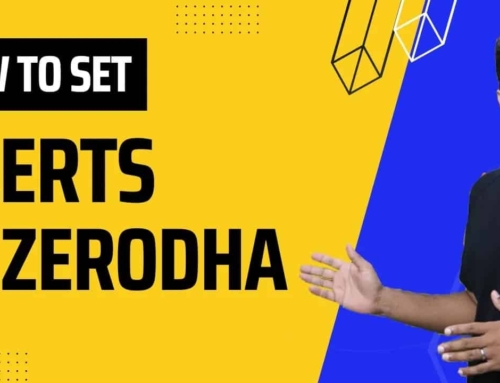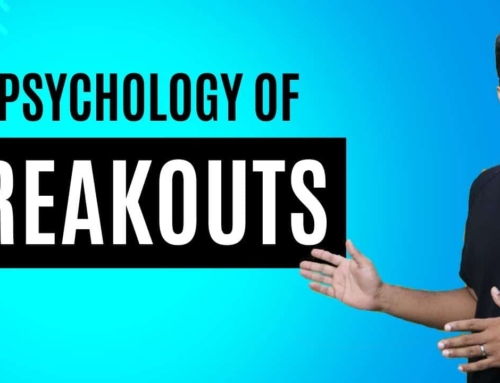Problem with Zerodha Kill Switch
A lot of you might be aware of the Kill Switch feature in Zerodha and the idea behind the kill switch feature is that if you don’t want to trade after a certain point of time during the day, you can turn this switch on and that will force you to stay out of the market for the rest of the day, i.e., for the next 12 hours.
This is a great feature and in fact, we had made a video about this sometime back which you can watch. This is because people who struggle with trading psychology, over-trading and who get tempted to take more and more trades during the day can bring some discipline in their life by using this feature.
The reason that I’m making this video is because Kill Switch has a problem, and I’m seeing this problem for the first time and I thought I will bring this up for all of you guys so that we can bring it to Zerodha so that they can do something about it. So, this is what happened. Today is Wednesday.
As you all know, it’s a very active day for options sellers and I was also very active today, but the market was not very charitable. In fact, the market was very choppy, and actually became violent. I, though was able to manage my trades in such a way that somewhere by 2 o’clock I came out of all my losses and I was sitting on a very small profit of somewhere around 3 to 4 thousand rupees.
It was at that time, I activated the Kill Switch in all my segments and you can see right here that since I activated it at 2:12 PM, I can only activate it after 12 hours. So once I did this, I was rest assured that everything is fine and that there was nothing to worry about.
I then started focusing on the other things that I had to take care of. Somewhere around 2 45, when I came back and I looked at the terminal, I was very surprised to see that I was actually in an open position and this is that position. Of course, I was sitting on a loss at that time. This position got activated and I was sitting on a loss of about 27,000 rupees.
I had no idea what had happened, but in order to make sure that I did not incur a bigger loss, I quickly closed my position and the profit that I had of around 3 to 4 thousand rupees got wiped out and I closed the day in the red with a loss of about Rs.25,000.
Now, if you see the orders and this is what is going to be very important here. If you remember, I activated the kill switch by 2:12 PM. So, immediately after this particular trade right here, I had activated the kill switch, but there was an open order in the system.
At 2:42 PM, after I had activated the kill switch and in spite of having the kill switch activated for the Futures and option segment, it still got executed. As soon as I realized that there was an open trade, I had to take action and so I closed it. Hence I had to incur a loss of about 27,000 rupees.
So then I went back to see what went on and whether I missed something. This is because, when you go to Kill Switch, you know the way it works. It is very clearly mentioned on Zerodha’s website that you need to log into the account section of the console, choose the segments you wish to disable and confirm. This will check if you have any open orders or position.
Hence the onus or the responsibility of whether or not kill switch should be activated is upon Zerodha as per their website. They will check if you have any open orders or positions and in the absence of any open orders or positions, the segment will get deactivated. Now, in my case, there was an open order in the system and in spite of that, they deactivated the segment and after deactivating the segment, that order still got executed.
Hence, firstly, they should have given me an error that there is an open order and it needs to be cancelled before disabling. At the very least, once that segment has been deactivated, they should have made sure that this order should have been cancelled.
Anyways, I have raised a ticket about this issue and it’s not a big amount or a big deal for my account. However, the reason that I’m making this video is to first of all generate awareness that just because you have activated the kill switch doesn’t guarantee that no further orders will be executed in your system.
As we saw, in my case, this order did get executed and that is number 1. Number 2 is you always need to take responsibility of your pending orders. Make sure that after you’re done with the trades, you cancel those orders and this was my mistake. I should have done that and not just simply relied on that Kill Switch.
This is one scenario that I was able to figure out and I don’t know about other scenarios in which the Kill Switch might not work. So please make sure that you do your due diligence and not just rely on Zerodha or this feature to prevent any further trading during the day.
There is one last thing that I want to say that I saw this issue for the first time and based on my understanding of how kill switch should work, I believe that this is an issue with Zerodha, but if you guys know more about kill switch, or if you know that Zerodha has mentioned some other conditions that I’m not aware of do let me know as I may be wrong.
However, I still thought that it was better to put this information out for others to know so that anybody who keeps any pending orders and assumes that kill switch will take care of it should not incur a loss, just like I did.
So that’s the reason I’m making this video and I just want to be clear about that.
Anyways, all the best.
 What is it?
What is it?
Under the peak margin rule imposed by SEBI, traders are required to give 100 percent margin upfront for their trades. This, experts feel, will severely impact intraday trades. It may also be noted that Sebi introduced new margin rules a year ago for day traders.
Under the new peak margin norms, stockbrokers are required to collect minimum margins on leverage-based trade upfront, compared to the earlier practice of collecting it at the end of the day.
Sebi had decided to introduce the peak margin norms last year in order to curb speculative trading and restrict leverages offered by stockbrokers to their clients.
After the new norms were announced, stockbrokers stopped using end-of-day positions to calculate margin requirements and shifted to using intraday peak positions from December 2020.
Under these new norms, Clearing Corporations will seek minimum margin throughout the session and force brokers to collect additional margin from clients if they fall short. Stockbrokers who fail to do so will face a penalty.
As a risk mitigation measure, additional leverage will also be restricted and stockbrokers will be penalised if leverage offered to clients exceed VaR + ELM and standardised portfolio analysis risk for derivatives positions.
Stockbrokers will also face a penalty if margins collected from traders is less than 100 per cent of trade value in the case of cash market stocks and an additional Span + Exposure for derivatives trade.
SPAN Margin is the minimum requisite margins blocked for futures and option writing positions as per the exchange’s mandate.
The ‘Exposure Margin’ is the margin blocked over and above the SPAN to cushion for any MTM (Marked-to-market) losses.
Both the SPAN and Exposure margins are specified by the exchange. So at the time of initiating a futures trade, the client has to adhere to the initial margin requirement. The entire initial margin (SPAN + Exposure) is blocked by the exchange.
As per the new peak margin norms, the margin requirements will be calculated 4 times during every trading session. It will also include intraday trading positions.
Traders will now have to park more cash towards fulfilling margin requirements for trade. In fact, trading in futures and options (F&O) will also become more expensive.
Earlier, stockbrokers’ association ANMI had termed the market regulator’s new peak margin rule as unfair and it had even urged Sebi to reconsider its peak margin norms, especially related to intra-day trading.
Traders too are dejected with the new rule as they will have to cough up more money to bet in the stock market, especially for intraday and futures trades. Further, traders will also have to pay a penalty if the peak margin norms are not followed during a trading session.
Zerodha has a page on their website to find out the SPAN & Exposure margin required for a futures position or short option.
As per SEBI regulations, margin shortfall penalty is levied on trades performed without sufficient margin (SPAN & Exposure for F&O and VAR+ELM+Adhoc for equity), net buy premium, physical delivery margins and marked to market losses (if applicable) as prescribed by the exchange.
The charges imposed are given below.
| Short collection for each client | Penalty percentage |
| (< Rs 1 lakh) And (< 10% of applicable margin) | 0.5% |
| (= Rs 1 lakh) Or (= 10% of applicable margin) | 1.0% |
To understand why a penalty is levied, we will have to first understand about the Settlement cycle and the concept of Margin reporting in India.
The settlement cycle in India for Equities is T+2 and for F&Os, it is T+1. When you sell Equities and receive money as sale proceeds, such sale proceeds can be withdrawn only on T+2 day.
If you sold stocks worth Rs.1,00,000 on Monday, you would be able to withdraw these funds only on Wednesday. Monday would be taken as T-Day, Tuesday would be T+1 Day and Wednesday would be T+2 Day). Similarly when you sell F&O positions you would be able to withdraw these funds on T+1 day only.
The thing to be noted here is that when you sell an Equity position or an F&O position, only on the respective settlement day the funds become yours and you can use them. From the time you sell till the time it is settled, they would be considered as “Encumbered funds”.
Margin Reporting: When you take a position in the F&O Segment, the Exchange requires all brokers to report the funds available for such positions taken by client on a client to client level.
If you buy Nifty Options for ₹ 10 Lakhs, the Exchange would ask your broker of the availability of funds in your account and report the same to the Exchange. While reporting the availability of funds, your broker is required to consider only ‘free’ or ‘unencumbered’ balance. Any short reporting will attract a penalty. If your broker allows you to buy options worth ₹ 10,00,000 with only ₹ 6,00,000 in your account, the shortage in your account would be ₹ 4,00,000 on which a penalty is levied.
Why the restriction on intraday leverages?
Peak margin reporting was introduced to restrict brokers from providing additional leverage over and above what VAR+ELM ( with minimum 20% for stocks) and SPAN + Exposure (F&O – Equity, Commodity, Currency) already being offered.
Effective Dec 1st, 2020, the maximum intraday leverage offered by a broker has been restricted and this maximum leverage kept reducing until 01st Sep 2021 post which a broker could give maximum leverage = VAR+ELM(min 20%) or SPAN+Exposure.
- Dec 2020 to Feb 2021 — penalty if margin blocked is less than 25% of the minimum and 20% of trade value (VAR+ELM) for stocks or SPAN+Exposure for F&O.
- March 2021 to May 2021 — penalty if margin blocked less than 50% of the minimum margin required.
- June 2021 to Aug 2021 — penalty if margin blocked less than 75% of the minimum margin required.
- From Sept 2021 — penalty if margin blocked less than 100% of the minimum margin required.
The minimum margin is VAR+ELM(with a minimum 20%) for stocks and SPAN +Exposure for F&O. This minimum margin inherently has leverage, but there can’t be any additional leverage over and above this.
Until now, brokerage firms could offer any amount of intraday leverage, and now they cannot. Starting Dec 1, 2020, there is a maximum intraday leverage that could and this maximum intraday leverage kept going down from Dec 1, 2020, to Aug 31, 2021. However, from Sep 1, 2021, the maximum intraday leverage is equal to the SPAN+Exposure margin for F&O (Equity, commodity, currency) and VAR+ELM(with a maximum 20%) for stocks.
What do you mean by SPAN+Exposure & VAR+ELM?
This is the minimum margin that exchanges ask brokers to collect from the clients on an end of the day basis for any open position on that particular trading day. If this margin is not collected, there is a penalty on whatever margin was collected short and is called the short margin penalty. This penalty can be in the range of 0.5% to 5% of the shortfall per day.
What changes post peak margin penalty?
Since margin reporting happened only on an end of the day basis, brokerage firms allowed customers to take intraday positions with margins far lesser than VAR+ELM or SPAN+Exposure.
However, these additional intraday leverages offered through products like MIS, BO, CO, etc. would forcibly be squared off before the close of trading hours, ensuring there is no margin penalty on the end of the day open positions.
For example,
- If Reliance VAR+ELM is 20%. Instead of asking ₹ 2,00,000 for a ₹ 10 Lakhs Reliance intraday trade (MIS, CO, BO), some brokers would ask for only 5% or Rs 50,000.
- If Nifty futures required SPAN+Exposure of ₹ 1.5L, brokers would allow customers to trade intraday with say just 30% of this amount or ₹ 50,000.
The problem is that when a broker collects a lesser margin than the minimum from the client, the broker takes an additional risk. These margins are collected to protect the broker from client defaults.
For example, if a broker allows a customer to trade for ₹ 10 Lakhs with only ₹ 10,000 or 1% and if the stock moves say 10% instantly, the customer loses ₹ 10,000, but the broker loses ₹ 90,000 (until the broker is able to recover the money from the customer).
Competition forced some brokers to attract clients by offering excessive intraday leverages (50 to 100 times). This caught the attention of the regulator, especially after the issues at Karvy, BMA, etc.
In order to fix these issues once and for all, SEBI introduced the concept of peak margin penalty. This is similar to how a margin penalty is calculated if the margin collection is lesser than the minimum for the end of the day position. Now the same logic will be used to calculate margin penalty if the available margin is lesser than the minimum SPAN+Exposure (Equity, Commodity, Currency) or VAR+ELM margin at any point during the trading day (intraday).
Since this practice of additional intraday leverages was prevalent for several decades, SEBI gave enough time for the industry to adjust. The circular was put out in Aug 2020 and from Dec 2020 to Sep 2021 the restriction slowly increased.
- Dec 2020 to Feb 2021 — penalty if margin blocked is less than 25% of the minimum 20% of trade value (VAR+ELM) for stocks or SPAN+Exposure for F&O.
- March 2021 to May 2021 — penalty if margin blocked less than 50% of the minimum margin required.
- June 2021 to Aug 2021 — penalty if margin blocked less than 75% of the minimum margin required.
- From Sept 2021 — penalty if margin blocked less than 100% of the minimum margin required.
The minimum margin is VAR+ELM for stocks and SPAN +Exposure for F&O and this minimum margin inherently has leverage, but there can’t be any additional leverage over and above this.
How does it affect the traders and the Broking industry?
There are brokerage firms who have used additional intraday leverage as a marketing ploy to attract customers. Now with the new SEBI rules, higher the intraday leverage offered by a broker today, the more that business will be affected. The lesser the leverage, the less the effect will be for that brokerage firm.
For Traders
Intraday trading contributes significant liquidity to the markets. With restrictions on intraday leverage, the liquidity is bound to reduce and hence the costs for everyone might go up. However, one positive aspect from all this is that since high leverage is what usually destroys the careers of traders, now, without such high leverages, the chances of a trader surviving the market will go up significantly.
Hopefully the higher number of traders participating at any time will make up for the drop in liquidity.

 What is it?
What is it?

![What is Virtual Contract Note [Zerodha]](https://www.vrdnation.com/wp-content/uploads/2023/10/maxresdefault-virtual-note-500x383.jpg)



Leave A Comment